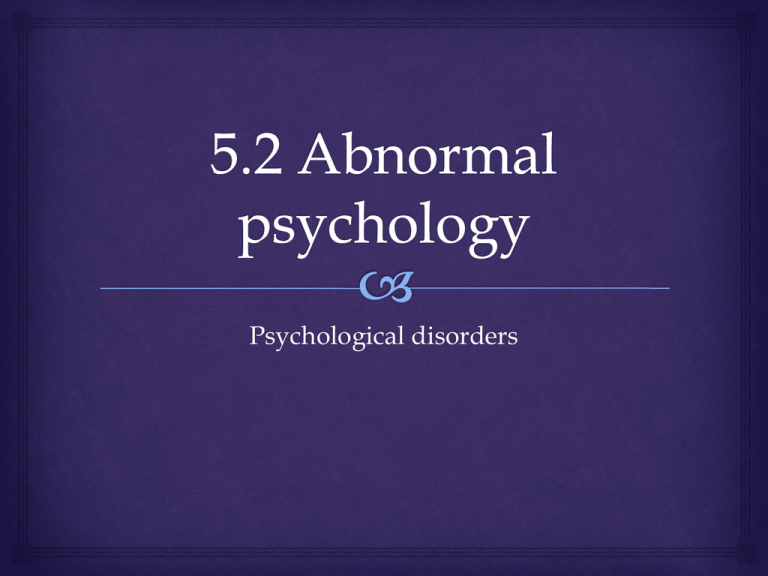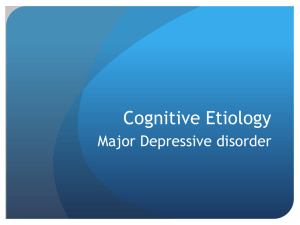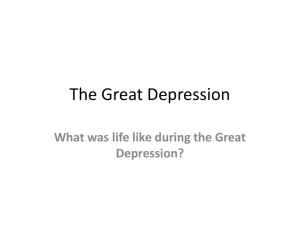5.2 psychological disorders
advertisement

Psychological disorders Affective Disorders – Major Depression Anxiety Disorder OCD, PTSD Generalized anxiety disorder (GAD), social phobia Introduction to psychological disorders- Vocab Symptomology Identification of the symptoms Etiology The ‘why’ people suffer, the origin of. Understanding the origin requires holistic approach. Prevalence rate Total number of cases of a specific disorder in a given population Lifetime prevalence (LTP) The % of population that will experience the disorder at some time Onset age Average age in which the disorder is likely to appear. Evaluate Psychological research relevant to the study of abnormal behavior Evaluate through theories and studies Major Depression Affective disorders: Major Depression Diagnostic Criteria Experiences symptoms for 2 weeks Loss of pleasure or interest Depressed mood Current research suggest that there are Biological – genetic make-up and biochemical factors Cognitive – thoughts of hopelessness, low self-esteem Sociocultural factors – stress of poverty, loneliness or troubles personal relationships Treatment Drug and therapy Symptoms Major Depression Affective: feeling of guilt or sadness; lack of enjoyment or pleasure in familiar activities or company Behavior: passivity; lack of interest Cognitive: frequent negative thoughts; faulty attribution; low self esteem; suicidal thoughts; difficulties concentrating, inability to make a decisions Somatic: loss of energy; insomnia, weight gain/loss; diminished libido These symptoms interfere with normal work and relationships Major Depression LTP = 15% Health department 1990 2-3x more common in women then men More frequent among lower socioeconomic groups Most frequently among adults. Prevalence rate higher in Jewish males vs other males. 80% reoccurrence rate, with a typical episode lasting 3-4 months; 12% of cases, depression can be chronic, lasing as long as 2 years. Be a thinker pg 149 1. Is Jane depressed? Support your claim 2. What could be contributing to her state of mind? 3. If you were Jane’s doctor, what questions could you ask her in order to identify possible causes of her condition? 4. What could you suggest to help Jane? State your reasons. Etiology Depression Onset of depression can be brought about by biological factors or an adverse social and environmental change. Most will represent complex interactions between physiology and psychological. Some depression is brought about by long-term circumstances, which are a continuing source of stress and disappointment. Not all people become depressed when stressed There are important distinctions in vulnerability: Genetic predisposition Personality and early history Cognitive style Coping skills Level of social support Major depression is NOT caused by a single factor – there is no 1 cause of depression. BLOA: genetic factors depression Twin Studies: Concordance rate higher in MZ twins vs DZ twins Genetic factors might predispose people for depression. Assessing seven studies Average concordance rate MZ = 65% - this is below 100%, thus can only suggest a predisposition (genetic vulnerability) DZ = 14% These findings do not contradict stress or environmental aspects. Biochemical Hypothesis of depression Catecholamine hypothesis Serotonin Hypothesis Cortisol Hypothesis Caspi (2003) genetic factors could moderate responses to the environment (findings are still premature) Neurobiology depression may be caused by neurotransmitters and hormone deficiency Catecholamine hypothesis: Joseph Schildkraut 1965 Depression is associated with low noradrenaline → serotonin hypothesis Drugs that decrease NE bring about depression like symptoms Use of Physostigmine (Janawskuy et al., 1972) resulted in individuals feeling depressed, self hate and suicidal within minutes of having taken the drug. Addition of NE reduces symptoms. NT Imbalances Delgado and Moreno (2000) – abnormal levels of NE and 5-HT. Rampello et al., (2000) – NE, 5-HT, DA and acetylcholine may all contribute. Criticism of 5-HT hypothesis It is not possible to measure brain serotonin levels Which comes first – the chicken or egg Does depression alter neurotransmitters or does alteration in neurotransmitters create depression? Cortisol hypothesis Stress hormone Family of glucocorticoids that play a role in anxiety and fear reactions,. High levels of cortisol in individuals with depression. Long term structural changes may be seen – hippocampus (memory) loses neurons; reduction of glucocorticoid receptors in prefrontal cortex and hippocampus of suicide victims. Cushing’s Disease – excess cortisol production - high prevalence of depression. Over-secretion of cortisol may be linked to other neurotransmitters. Lower 5-HT receptors Impair NE receptors Research in Psychology page 153 Impact of poverty on child depression Fernald and Gunnar (2009) – Surveyed 639 Mexican mothers and children Children of depressed mothers in extreme poverty produced less cortisol Suggest that the stress system is “worn out” Be empathetic Produce a list of stressors which you think poverty causes individuals. If you were in public office, what would you propose in order to alleviate some of these stressors? Video Depression (1) how depression changes the brain Depression (2)Impact of childhood events Depression (3) Role of inflammation in depression Depression (4) The best treatment for depression Depression (5) The effects of treatment on the brain. CLOA: cognitive factors, depression Cognitive theories of depression: Depressed cognition Cognitive distortions Irrational beliefs Ellis (1962) – psychological disturbances often come from irrational and illogical thinking. People draw false conclusion which lead to feelings of anger, anxiety or depression. “my work must be perfect” & “my essay did not receive top grades” → defeating conclusion, “since I did not receive the highest grade I am stupid” Cognitive Distortion:Beck’s theory of cognitive vulnerability factors. Distortion based upon schema processing: Stored schema about the self interfere with information processing Triggered by stressful events Tends to overreact Depressive patients experience a negative cognitive triad: Overgeneralization based on negative events The world is unfair Non-logical inferences about the self The self is worthless Dichotomous thinking – “black and white” thinking, selective recall of negative consequences. The future is hopeless Cognitive Triad The Self “I am a bad person” Experiences “My life is terrible” The Future “things will not improve” Beck: Silent Assumptions Cognitive thoughts of depressed people are dominated by a set of assumptions that shape conscious cognition These assumptions are derived from our environment Parents, teachers, friend ”I must get approval” “I must do thing perfectly” “I must be valued by other or I am worthless” Beck: Informational processing How depressed people are prone to distortion of misinterpretation. Arbitrary inferences – drawing negative conclusions based on limited information Selective thinking – focusing on negatives Overgeneralization – jumping to conclusion based on a single incidence Personalizing – taking blame/responsibility for all unpleasant things that happen Black and White thinking – seeing everything in terms of success and failure Beck Activity Read page 154 Is it possible that depression is mostly related to cognitive factors? Present two claims and support with evidence. Which comes first – the cognitive thinking pattern triggers depression or does depression trigger the cognitive thinking pattern? SCLA: social and cultural factors, depression Diathesis-stress model = interactionist approach to explain psychological disorders. Brown and Harris (1978) – social origins of depression in women. Vulnerability model. Sociocultural factors Poverty Living in a violent relationship Stress of raising young children War Restricted gender roles Brown and Harris Aim: To determine how depression could be linked to social factors and stressful events in women. Procedure: 458 women surveyed on daily life and depressive episodes Results: Working class women with children were 4X more likley to develop depression than middle-class women with children 8% (37) of all women had clinical depression 33/37 (90%) experienced an adverse life event (death/abuse) 4/37 did not suffer adverse affect. 30% of the women who did not become depressed experienced the same adverse affects Brown and Harris Findings: 3 major factors that effect depression 1. Protective factors: high levels of intimacy with spouse – may induce higher self esteem/meaningful life 2. Vulnerability factors – loss of a mother before age 11; lack of confiding relationship; more than 3 children under the age of 14 at home; and unemployed 3. Provoking agents – contribute to acute and ongoing stress. Diathesis Stress model Brown and Harris vulnerability model supports the diathesis stress model: the interactive effect of heredity and environmental factors Cultural Considerations WHO (1983) assessing Iran, Japan, Canada and Switzerland – Common symptoms of depression Sad affect Loss of enjoyment Anxiety Tension Lack of energy Lost of interest Inability to concentrate Feelings of worthlessness These findings are consistent with earlier cultural studies done by Murphy et al., (1967) Culture cont., Marsella (1979) affective symptoms are associated with individualistic cultures; somatic symptoms are associated with collectivist cultures. Kleinman (1982) China somatization served as a typical channel of expression and basic component of depression. Prince (1968) claimed there was no depression in African and Asian cultures prior to westernization. Cross Culture research - each culture experiences almost identical core symptoms, and they may exhibit symptoms that are culturally specific. Gender Considerations in major depression Women are 2-3X more likely to become clinically depressed than men. It is a widely held belief that women are naturally more emotional than men, and therefor more vulnerable to emotional upsepts because of hormonal fluctuations. Is this a valid argument? Discuss the interaction of biological, cognitive and sociocultural factors in major depression. This prompt requires you to consider a number of explanations and evidence to support your argument The argument should include relevant research and theory. Relevant studies Depression Rosenhahn (1973): On being sane in an insane place Validity of diagnosis: DiNardo et al. (1993) Lipton and Simon (1985) Ethial Considerations Thomas Szasz Scheff (1966) labeling brings about self-fulfilling prophecy Langer and Abelson : prejudice and discrimination Cultural Considerations Rack (1982) – mental illness carries great stigma in China Relevant studies Depression Cochrane and Sashidharan (1995) Cultural blindness Biological: Cognitive: Beck Sociocultural: Brown and Harris: Elkin et al (1989) treatment Biomedical approaches to treating depression If the problem is based on biological malfunctioning, then it stand to reason that treating it medically should relieve symptoms Depression is known to involve imbalances in neurotransmitters – thus treating with drugs that realign the NT balance should alleviate symptoms. Not all patients respond the same way. Mode of action Drugs are designed to affect the neurotransmitters Dopamine (DA) (excitatory/inhibitory neuron) Serotonin (5-HT) (inhibitory neuron) Noradrenaline (NE) (excitatory neuron) GABA (gamma-aminobutyric acid) – (Inhibitory neurons) Mechanism of action Either inhibit or enhance the effect of the NT in question. SSRI’s Selective Serotonin Reuptake Inhibitors: Increase the level of 5HT at the synaptic cleft Fluoxetine most common SSRI used (Prozac) Effective, Relatively safe, side effects. Kirsh et al (2008) criticize “over prescription” of SSRIs SSRI’s Available Celexa citalopram hydrobromide Lexapro escitalopram oxalate Luvox fluvoxamine maleate Paxil paroxetine hydrochloride Prozac fluoxetine hydrochloride Zoloft sertraline hydrochloride NE and 5-HT approach Brand Name Generic Name Cymbalta duloxetine hydrochloride Effexor venlafaxine hydrochloride Remeron mirtazapine Increase NE and 5 HT levels Evaluation of Drug Therapy Short term treatment is successful for 60-80% of people (Bernstein et al. 1994) However, they are not equally effective in all cases. Kircsh and Sapirstein (1998) analyzing 19 studies (2318 patients treated with Prozac) found that the antidepressant was only 25% more effective than the placebos, and no more effective than other kinds of drugs, such as tranquillizers. Most psychiatrist agree that drugs provide effective long term control for mood disorders, and may help to prevent suicide in depressive patients. Side Effects and Ethical Issues Drug therapy cannot be given without consent unless it is an emergency. Drug therapy does not constitute a cure Criticism of the efficacy of antidepressants in comparison to placebo (Kirsch et al 2008) Blumenthal et al (1999) found that exercise was just as effective as SSRI’s in treating depression in an elderly group of patients. Leuchter and Witte (2002) Depressive patients receiving drug treatment improved just as well as patients receiving placebo Brain scans revealed changes in the brain in both cases but in different areas: Placebo – increased activity in prefrontal cortex (changes occurred 1 – 2 weeks into treatment) Antidepressant – reduced activity in prefrontal cortex (changes occurred within 48 hours) Although medication may be effective, there may be other effective ways to treat depression. Elkin et al. (1989) National Institute of Mental Health: 28 clinicians who worked with 280 patients diagnosed with depression Patients randomly assigned to treatment groups: Antidepressant + clinical management (imipramine) (double blind) Interpersonal therapy (ITP) or Cognitive behavioral therapy (CBT) Control = placebo with weekly therapy (double blind) All patients were assessed at the start, 16 weeks of treatment and 18 months Elkin cont., Results: 50% patients recovered in IPT and CBT as well as in the drug group 29% recovered in the placebo group Drug treatment produced fastest results The study suggests that it does not matter which treatment patients received, all treatments had the same result. OK Doctors – what do you think? Would it be acceptable to give a patient placebo pills instead of antidepressants? What arguments could you make for and against? Individual approaches to treatment of depression Aaron Beck pioneered the idea of cognitive restructuring, the core of cognitive behavior therapy. Approach to Cognitive restructuring: Identify the negative, self critical thoughts that occur automatically Note the connection between negative thought and depression Examine each negative thought and decide whether it can be supported Replace distorted negative thoughts with realistic interpretations of each situation. Cognitive behavior Therapy “a persons beliefs contribute to automatic thoughts” based on schema” Beck Negative self schemas bias a persons thinking. CBT – focuses on current issues and symptoms. 12-20 weekly sessions Daily practice exercises Behavior modification Aim of CBT 1. Identify and correct faulty cognitions and unhealthy behaviors. Identify what thoughts are associated with depressed feelings and to correct them – reconstruction – based on the foundation that assumptions may be distorted. 6 patterns of faulty thinking: Arbitrary inferences Selective abstraction Overgeneralization Exaggeration Personalization Dichotomous thinking Arbitrary Inference Drawing wrong conclusions about oneself by making invalid connections You think that only you have bad luck and that the world is against you. Selective Abstraction Drawing conclusions by focusing on a single part of a whole. Overgeneralization Applying a single incident to all similar incidents Exaggeration Overestimating the significance of negative events. Personalization Assuming that others’ behavior is done with the intention of hurting or humiliating you. Dichotomous thinking All or none approach Psychological problems are often prone to negative automatic thinking that they CANNOT control. Example: the negative thought, and exaggeration, “I never do anything right,” may be filtered through a cognitive schema, which processes the information to fit the biased self-perception. In short, the schema provides the resource for a form of conditioning nd 2 Aim CBT Behavioral Component Encourage individuals to increase rewarding seeking activities. Sports Music Gardening Cooking Sewing Teasdale (1997) the important feature of cognitive therapy is to teach the client meta-awareness – the ability to think about their own thoughts. The aim of therapy is to teach each client to monitor thought processes and then to test them against reality so they can eventually change the behavior on their own. How effective is cognitive therapy in treating depression? Rush et al (1977): highly effective Dobson (1989): superior to no treatment or to a placebo. Elkins et al (1989): no significant difference between CBT and Rx (tricyclic) Riggs et al (2007) : Looked at CBT with SSRI or placebo 67% CBT + placebo 76% CBT + SSRI Both groups were found to be - much improved or very much improved. Conclusion: treatment with drug is effective, treatment without drug is almost as effective. Nemeroff et al. (2003), CBT in combination with drugs was the most effective in chronic depression in people suffering traumatic childhood experiences. Ethically speaking – it is clear that the therapist is making judgments concerning which thought are acceptable. Group approaches to treatment of depression Couples Treatment Focus is on teaching couples how to communicate and problem solve more effectively while increasing positive interactions and reducing negative exchanges. More effective for women suffering from depression related to marital distress. Social Learning/interpersonal model Cases in Abnormal psychology pg 113 Describe symptoms and prevalence of one psychological disorder. Evaluate the use of one approach to the treatment of the disorder [22 Mark] Discuss the interactions of biological, cognitive, and sociocultural factors in abnormal behavior Describe the symptoms and prevalence of PTSD & Depression Analyze etiologies of PTSD and Depression Discuss cultural and gender variations in disorders








